-

人教版高中英语必修3Healthy Eating说课稿4篇
Language learning needs a context, which can help the learners to understand the language and then can product comprehensible output, so computer has the advantages to make the materials attractive.Part 3 Learning MethodsTask-based, self-dependent and cooperative learningPart 4 Teaching ProcedureStep One Lead-in“Interest is the best teacher.” Therefore, at the very beginning of the class, I should spark the students’ mind to focus on the centre topic “the band”. I’ll show some pictures of food to attract their attention and then bring some questions.Question:What kind of food they like?What should go into a good meal?The answers must relate to the diet. After this, the students will be eager to know something about a balance diet and this is the very time to naturally lead the class into Step 2Step 2 Reading for information: skimming and scanning In this step, I use Task-based Language Teaching method, which can give students a clear and specific purpose while skimming and scanning the context.Task 1 General ideaThe students will be asked to just glance at the title and the pictures of the passage, and then guess what they will read in the text. And they’ll be divided into groups of four to have a discussion.The purpose is to inspire the students to read actively, not passively. In addition, the task is to develop the students’ reading skill by making prediction and to encourage the students to express their thoughts in English and cooperate with each other.Task 2 Main idea of each paragraphCooperative learning can raise the students’ interest and create an atmosphere of achievement. Based on this theory, I divide the whole class into 4 groups to skim the whole text and get the main idea of each paragraph.

人教版高中英语必修4Working The Land说课稿3篇
Knowledge objectives:(1) to make Ss grasp the usage of words, expressions and sentence structures: statistics, struggle, thanks to, rid of, some patterns for persuasion, the “ing” form as subject and object;(2)to use learnt knowledge to persuade sb.Ability objectives:(1) to develop Ss’ reading skills(skimming, scanning, word guessing);(2) to improve Ss’ speaking, communicating and cooperating skills.Emotional objectives:to make Ss know the contribution of Yuan,and learn his spirit and his simple life time.Teaching important and difficult points:(1) some words, expressions and sentence structures mentioned above;(2)the content of the text;(3)training their reading and speaking skills.Teaching methods: CLT, TBLT,QT.Learning strategies: CLS, QLS, TBLS.Teaching procedures:Step 1 lead-in: (1) teacher plays a piece of recent news from CCTV about the harvest of the super hybrid rice, and ask students whether they know Yuan or not, and talk about him and his contribution.(2)Brain storm: let Ss describe Yuan in their minds including his appearance, his living condition and so on.Step 2 fast reading tasks:(1)teacher introduces Yuan and super hybrid rice(2)make Ss read the text as fast as possible with questions. Such as: what’s the general ideaof this passage? What’s Yuan’ dream? (skimming and scanning skill)Step 3 intensive reading tasks(1)let Ss read the text silently, find topic sentence of each paragraph and draw the difficult sentences and the knowledge what they don’t understand.(words guessing)(2)teacher and Ss talk about the important words, expressions and sentences together, and ask Ss to retell the content of the text.(summarizing and paraphrasing)(3)teacher summarize this part.(4) read again following the courseware.

人教版高中英语必修5First aid说课稿6篇
In this class, I have 3 teaching aims, that is, knowledge aims, ability aims and emotion aims.1) Knowledge-Teach students new words and expressions, such as temporary, bleed,sprain choke, first aid, fall ill and so on.-Enable students to have a better understanding for some basic knowledge of first aid.2) Ability-Train students’ speaking, reading and writing abilities by different teaching activities, such as skimming, comprehending, team work, role play, retelling and writing.-Develop students’ reading strategy on how to move general idea to specific information.3) Emotion-Promote students’ awareness of giving first aid.- Cultivate students’ creativities.Then let’s come to my teaching methods and activities.III. Teaching methods and activities:To achieve different teaching aims, various kinds of teaching methods and activities will be adopted throughout this period, such as TBL (task-based learning), skimming, team work, brainstorm and others, which can offer students opportunities to fulfill tasks in which they can use language to achieve a specific outcome.IV. Teaching aids:Computer and blackboardV. Teaching important points:1) Make students have a clear mind for the structure of the text.2) Help students understand the theme of the text.VI. Teaching difficulties:1) So many new words may affect students’ understanding.2) How to get students to know about the functions of the skin and thecauses, characteristics and treatments for different degree burns,and the knowledge about giving first aid. VII. Blackboard design:

人教版高中英语必修5Great scientists说课稿4篇
通过写文章梗概,培养学生综合运用语言的能力,学习用恰当的英语描述科学家的故事。这是本课的教学难点。教师可以使用完形填空的方式来帮助学生整理语篇,从而来降低难度。本课的教学重点的突破方法是:在阅读前,让学生初步了解得出科学观点所需要的基本程序,从而轻松而自然地导入文章的阅读;在阅读过程中,由易到难设计快速阅读和精读的问题,层层推进各种阅读活动,让学生对阅读内容从整体感知到细节理解,最后深层读懂整篇文章,同时加强阅读策略的指导,让每个学生都主动参与课堂教学活动,最终达到提高阅读能力的目的。Step 4 Post-readingGroup Activities四人小组共同合作,在老师的适当指导下,就以下2个问题展开讨论,让学生就所知、所学、所感和所想融入话题,然后抽若干同学代表作小组发言。1. What do you think about John Snow, and what should we learn from him?2. Cholera was 19th century disease, which two diseases are similar to cholera today? Why?

人教版高中英语必修5Life in the Future说课稿5篇
Good afternoon, everyone. It’s my great pleasure to be here sharing my lesson with you. The content of my lesson is Senior English for China Book5 Unit 3 Life in the Future. I’ll be ready to begin this lesson from six parts: Analysis of the teaching material, Analysis of the students, Teaching aims and important and difficult points, Teaching methods and aids, Teaching procedures, and Blackboard design. First, let me talk about the teaching material.Part 1 Analysis of the Teaching Material:This unit is about what human beings’ life will be like in about one thousand years. By studying of this unit, we’ll Enable the students to know the changes in humans’ life and some new inventions bringing about the change and develop the interest in science. This lesson plays an important part in the English teaching in this unit. This is an important lesson in Book Five. From this lesson, it starts asking the Ss to grasp contents of each passage. Therefore, this lesson is in the important position of the teaching material. If the Ss can learn it well, it will be helpful to make the Ss learn the rest of this unit.Part 2 Analysis of the SsAs Senior2 Ss, they are at different levels of English fluency, some of them have lost interest in English. So during the lesson, I arrange a variety of activities to let all of them join in to attract their interest and let them be confident and taste the joy of success.

人教版高中英语必修5Making the news说课稿4篇
今天我们来介绍一下必修五第四单元的授课方式。这个单元的题目是Making the news。应该是学生比较感兴趣的话题,学生往往对新闻工作充满好奇,所以我们可以利用这个机会多设计一些师生互动和学生互动,来激发起学习的积极性,提高学习效率。同时我们可以利用这个单元不仅帮助学生掌握语言知识,培养语言能力,同时让其了解新闻工作的重要性,培养起社会智能感。这个单元分为六个课时,它的教学目标是这样的:语言目标是掌握词汇表中的常用单词和短语,掌握倒装句的一些基本用法。 技能目标是能初步掌握约会的基本句型并在真实的场景下正确运用。新闻报道类文章的写作技能。采访的基本规范和沟通技能。情感目标是对新闻报道的客观性和真实性有更好的理解。对新闻记者的职业有更深入的了解,并能体会其工作的重要性。下面我们来介绍一下第一课时的授课方式,第一课的教学目标是这样的第一课时的教学目标语言目标:单词:Occupation, journalist, editor, photographer, curious, personality, enthusiasm

人教版高中英语必修5The United Kingdom说课稿4篇
Teaching Aims:Knowledge 1. Get the students to learn the useful new words and expressions in this section. Aims:2. Let the students learn about how the UK was formed and the four groups of invaders.1. Develop students’ reading ability and let them learn different Ability reading skills. Aims:2. Enable students to learn to talk about the United Kingdom and the Union Jack Emotional 1. Let students know more about the UK2. Develop students’ sense of cooperative learning Aims:Teaching Important Points:1. Let the students learn about the countries of the United Kingdom and the Union Jack2. Get the students to read the passage and know about how the UK was formed and the four groups of invaders.3. Have the students learn different reading skills.Teaching Difficult Ponts:1. Develop students’ reading ability.2. Enable students to talk about the United Kingdom and the Union Jack.3. Let students learn how the UK was formed geographically and historically.Teaching Methods:Showing pictures, asking, exercising, listening, reading etc.Teaching Aids:A computer,a projector and a blackboard.Teaching Procedures: 1) Show a map of the world, ask students the following questions:Where is the UK?What’s the full name of the UK?2) Ask the students work in pairs to do the quiz on Page 9.Do you want to test how many things you know about the United Kingdom? Let’s have a small test.Using the map on P9, students answer the following questions:?How many countries does the UK consist of? What are they??England is divided into three main areas. Do you know what they are? 1) Scanning (10Minutes )Let the students hold the questions asked in pre-reading and read the passagequickly and then let them do the following exercise.Join lines to the right answer.
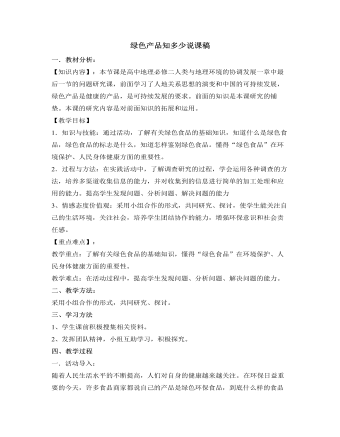
人教版高中地理必修2绿色产品知多少说课稿
各小组派代表汇报。4、教师提出问题组织学生讨论:⑴要想了解更多的绿色食品,了解绿色食品的销售情况,我们应该怎么做?⑵要想了解广大消费者对绿色食品的态度,食用绿色食品的意义,是否懂得辨认绿色食品,以及什么样的人群对此知识最缺乏等,我们应该怎么做?组织学生汇报交流。5、做个“绿色食品”广告设计师。为你喜欢的绿色食品设计广告语,每组推荐一个。6、让学生了解绿色食品认证程序。7、绿色食品打“假”队员在行动。8、向学生介绍生态绿色食品基地。三、活动总结:通过研究、探讨,了解学生对绿色食品的态度。提问:民以食为天,吃,是一个大问题,如果你的爸爸妈妈让你到超市买牛奶、方便面等,你会选择什么样的食品?为什么?希望通过今天的学习,同学们能够做到绿色消费,也希望你们向自己的家人、向周围的了解学生对“无公害食品”、“有机食品”与“绿色食品”的认识。
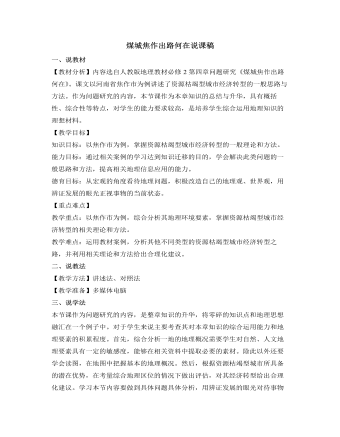
人教版高中地理必修2煤城焦作出路何在说课稿
分析过焦作市的地理概况和产业优势后,就需要针对由于资源枯竭所带来的问题提出合理化的建议。既然是谈经济转型,就应该将话题的范围明确在这一领域内。通过材料3的相关内容,我们了解到焦作市需要在产业结构调整、培育新的优势产业、增强综合竞争力等三个整改方针上下功夫。因而引导学生针对优势与不足提出建议,以三个整改方针为基准,衡量建议的可行性是锻炼学生解决此类问题的有效途径。在此我将教会学生的是解决问题方法而非案例的内容,正所谓“授之以鱼,不如授之以渔”。接下来针对学生的建议和教材资料分析所罗列的10点整改思路,由学生自由发言提出看法,通过教师的指导和学生的讨论,进而确定经济转型建议的具体方案。最后注意将建议与产业优势相对照,看建议是否都是围绕着产业优势而提出的,这样做会加深学生的印象,通过建议和优势的对应关系,将不难找出此类问题的解题思路。
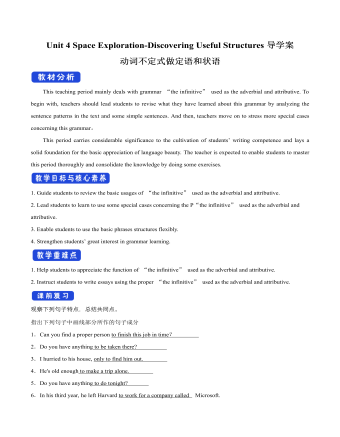
新人教版高中英语必修3Unit 4 Space Exploration-Discovering Useful Structures导学案
【点津】 1.不定式的复合结构作目的状语 ,当不定式或不定式短语有自己的执行者时,要用不定式的复合结构?即在不定式或不定式短语之前加 for +名词或宾格代词?作状语。He opened the door for the children to come in. 他开门让孩子们进来。目的状语从句与不定式的转换 英语中的目的状语从句,还可以变为不定式或不定式短语作状语,从而使句子在结构上得以简化。可分为两种情况: 1?当目的状语从句中的主语与主句中的主语相同时,可以直接简化为不定式或不定式短语作状语。We'll start early in order that/so that we may arrive in time. →We'll start early in order to/so as to arrive in time. 2?当目的状语从句中的主语与主句中的主语不相同时,要用动词不定式的复合结构作状语。I came early in order that you might read my report before the meeting. →I came early in order for you to read my report before the meeting.
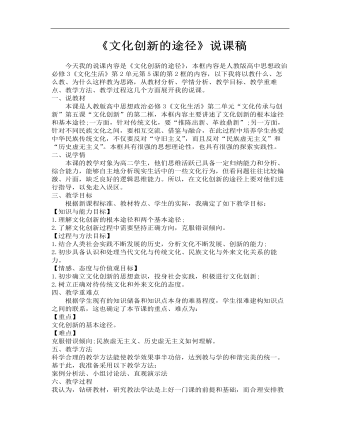
高中思想政治人教版必修三《文化创新的途径》说课稿
二、说学情本课的教学对象为高二学生,他们思维活跃已具备一定归纳能力和分析、综合能力,能够自主地分析现实生活中的一些文化行为,但看问题往往比较偏激、片面,缺乏良好的逻辑思维能力。所以,在文化创新的途径上要对他们进行指导,以免走入误区。三、教学目标根据新课程标准、教材特点、学生的实际,我确定了如下教学目标:【知识与能力目标】1.理解文化创新的根本途径和两个基本途径;2.了解文化创新过程中需要坚持正确方向,克服错误倾向。

人教版高中地理必修1第一章第一节宇宙中的地球说课稿
(一)教材的地位与作用本节描述地球所处的宇宙环境包括两部分内容,一是能在天体系统中确定地球所在位置,二是结合太阳燃烧的稳定状态和大行星运轨道特征,说明地球存在生命的宇宙环境特征。这里需要补充太阳大小长期稳定的燃烧保证地球表面长期保持适宜的温度,有利生命进化;大小行星公转各行其道,保证地球宇宙环境的安全。这两点宜在讨论地球是特殊的行星时补充。说明地球是太阳系中一颗既普通又特殊的行星要通过 3引导学生从图文资料中找出地球与其他行星在运动特征和结构特征上的共性以及轨道位置和自身条件上的特性。运动特征共性包括同向性、共面性和近圆性;结构特征主要是通过与类地行星比较得出地球在质量和体积方面不具特殊性。地球上存在生命主要是因为日地距离适中,所以有适合的温度;因为地球质量和体积适中,所以能吸引住大气形成厚度、压力适合的大气层;因为地球存在岩浆活动,所以有地球内部氢氧分异化合的水汽溢出形成海洋。
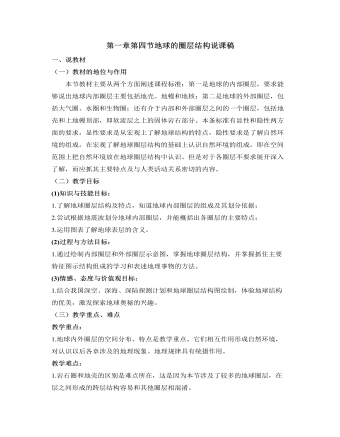
人教版高中地理必修1第一章第四节地球的圈层结构说课稿
(一)教材的地位与作用本节教材主要从两个方面阐述课程标准:第一是地球的内部圈层,要求能够说出地球内部圈层主要包括地壳、地幔和地核;第二是地球的外部圈层,包括大气圈、水圈和生物圈;还有介于内部和外部圈层之间的一个圈层,包括地壳和上地幔顶部,即软流层之上的固体岩石部分。本条标准有显性和隐性两方面的要求,显性要求是从宏观上了解地球结构的特点,隐性要求是了解自然环境的组成。在宏观了解地球圈层结构的基础上认识自然环境的组成,即在空间范围上把自然环境放在地球圈层结构中认识。但是对于各圈层不要求展开深入了解,而应抓其主要特点及与人类活动关系密切的内容。(二)教学目标(1)知识与技能目标:1.了解地球圈层结构及特点,知道地球内部圈层的组成及其划分依据;2.尝试根据地震波划分地球内部圈层,并能概括出各圈层的主要特点;3.运用图表了解地球表层的含义。
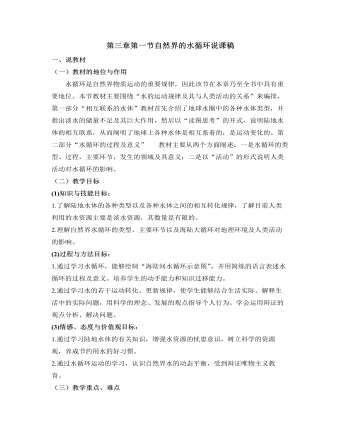
人教版高中地理必修1第三章第一节自然界的水循环说课稿
二、说学情学生对自然界中的水循环已具有一定的生活体验和知识基础,主要问题是学生还未上升到理性的层面上进行分析,而且自然界的水循环属于全球尺度和大尺度的地理现象,学生难以理解,需要教师创设适当的情境引导学生进行新知的建构。三、说教法(1)创设情景:教学实践证明,合理有趣的情境创设,可以引导学生快速进入角色,提高课堂效率(2)讨论法:通过组织学生讨论,给学生提供自主学习、合作学习、探究学习的机会。(3)多媒体演示法:利用多媒体播放一些直观的图片、动画和数字资料,把学生轻松得引入本课,通过形象生动直观地展现相关地理事物和现象,提高学生的感性认识,激发兴奋点,帮助他们理解课本内容。四、说学法(1)学会用图:让学生仔细观察图3.2和图3.3理解水循环的相关性(2)学会探究:学生思考分析总结水循环的地理意义及黄河断流的原因。
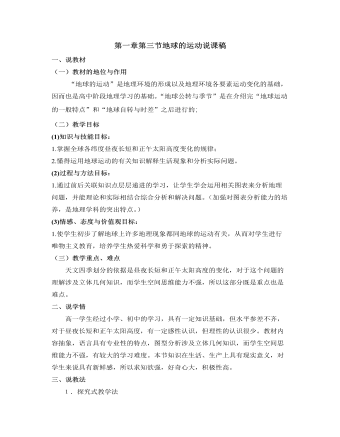
人教版高中地理必修1第一章第三节地球的运动说课稿
(一)教材的地位与作用“地球的运动”是地理环境的形成以及地理环境各要素运动变化的基础,因而也是高中阶段地理学习的基础。“地球公转与季节”是在介绍完“地球运动的一般特点”和“地球自转与时差”之后进行的;(二)教学目标(1)知识与技能目标:1.掌握全球各纬度昼夜长短和正午太阳高度变化的规律;2.懂得运用地球运动的有关知识解释生活现象和分析实际问题。(2)过程与方法目标:1.通过前后关联知识点层层递进的学习,让学生学会运用相关图表来分析地理问题,并能理论和实际相结合综合分析和解决问题。(加强对图表分析能力的培养,是地理学科的突出特点。)(3)情感、态度与价值观目标:1.使学生初步了解地球上许多地理现象都同地球的运动有关,从而对学生进行唯物主义教育,培养学生热爱科学和勇于探索的精神。

人教版高中地理必修1第二章第一节冷热不均引起大气运动说课稿
4、【自主探究】巴山夜雨的成因③材料三:三国时期,诸葛亮于农历6月的一天,在葫芦峪设下伏兵,打算用火攻全歼司马懿。这一天,晴空万里暑热难耐,真乃火攻之良机。诸葛亮依计将司马懿之众诱入谷中……然而,正当大火冲天,司马懿全军行将覆灭之时,一场大雨不期而至,大雨浇灭了诸葛亮扶汉反魏的壮志,使他喊出了“谋事在人,成事在天,不可强也”的千古悲歌。【设计理念】前后呼应,发散思维。通过自主探究,学生各抒己见,完成对热力环流整个知识框架的一个总结,既考查了学生的课堂学习效果,又锻炼了学生知识的迁移能力,并认识生活中的地理规律,用生动的语言拉近学生与大气理性知识的距离,体会到地理学科的重要性。【提问】如果将白天换成夏季,将夜间换成冬季,情况又会怎样?城市与郊区之间也存在着热力环流——城市风,它们是怎样形成的?了解城市风的出现有何重要意义?如果地球上在赤道和两极之间存在热力环流,这个热力环流应该怎样?这几个问题,请大家课后慢慢思考。
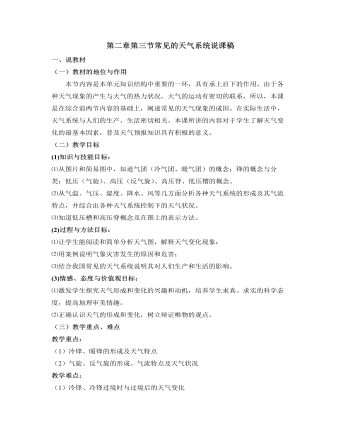
人教版高中地理必修1第二章第三节常见的天气系统说课稿
一、说教材(一)教材的地位与作用本节内容是本单元知识结构中重要的一环,具有承上启下的作用。由于各种天气现象的产生与大气的热力状况、大气的运动有密切的联系,所以,本课是在综合前两节内容的基础上,阐述常见的天气现象的成因。在实际生活中,天气系统与人们的生产、生活密切相关。本课所讲的内容对于学生了解天气变化的最基本因素,普及天气预报知识具有积极的意义。(二)教学目标(1)知识与技能目标:⑴从图片和简易图中,知道气团(冷气团、暖气团)的概念;锋的概念与分类;低压(气旋)、高压(反气旋)、高压脊、低压槽的概念。 ⑵从气温、气压、湿度、降水、风等几方面分析各种天气系统的形成及其气流特点,并综合出各种天气系统控制下的天气状况。⑶知道低压槽和高压脊概念及在图上的表示方法。(2)过程与方法目标:⑴让学生能阅读和简单分析天气图,解释天气变化现象;⑵用案例说明气象灾害发生的原因和危害;
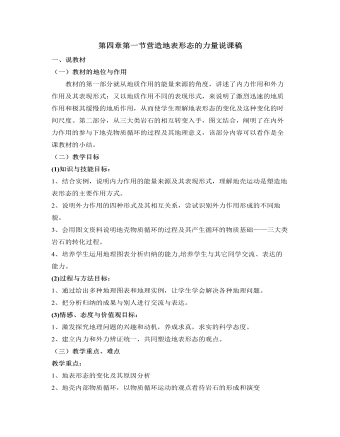
人教版高中地理必修1第四章第一节营造地表形态的力量说课稿
(一)教材的地位与作用教材的第一部分就从地质作用的能量来源的角度,讲述了内力作用和外力作用及其表现形式;又以地质作用不同的表现形式,来说明了激烈迅速的地质作用和极其缓慢的地质作用,从而使学生理解地表形态的变化及这种变化的时间尺度。第二部分,从三大类岩石的相互转变入手,图文结合,阐明了在内外力作用的参与下地壳物质循环的过程及其地理意义,该部分内容可以看作是全课教材的小结。(二)教学目标(1)知识与技能目标:1、结合实例,说明内力作用的能量来源及其表现形式,理解地壳运动是塑造地表形态的主要作用方式。2、说明外力作用的四种形式及其相互关系,尝试识别外力作用形成的不同地貌。3、会用图文资料说明地壳物质循环的过程及其产生循环的物质基础——三大类岩石的转化过程。4、培养学生运用地理图表分析归纳的能力,培养学生与其它同学交流、表达的能力。
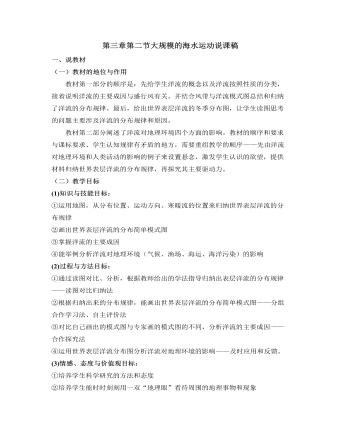
人教版高中地理必修1第三章第二节大规模的海水运动说课稿
(一)教材的地位与作用教材第一部分的顺序是:先给学生洋流的概念以及洋流按照性质的分类,接着说明洋流的主要成因与盛行风有关。并结合风带与洋流模式图总结和归纳了洋流的分布规律。最后,给出世界表层洋流的冬季分布图,让学生读图思考的问题主要涉及洋流的分布规律和原因。教材第二部分阐述了洋流对地理环境四个方面的影响。教材的顺序和要求与课标要求、学生认知规律有矛盾的地方,需要重组教学的顺序——先由洋流对地理环境和人类活动的影响的例子来设置悬念,激发学生认识的欲望,提供材料归纳世界表层洋流的分布规律,再探究其主要驱动力。(二)教学目标(1)知识与技能目标:①运用地图,从分布位置、运动方向、寒暖流的位置来归纳世界表层洋流的分布规律②画出世界表层洋流的分布简单模式图③掌握洋流的主要成因
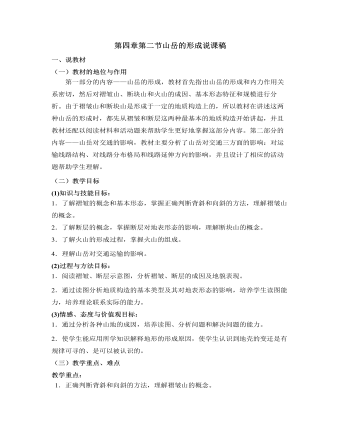
人教版高中地理必修1第四章第二节山岳的形成说课稿
(一)教材的地位与作用第一部分的内容——山岳的形成,教材首先指出山岳的形成和内力作用关系密切,然后对褶皱山、断块山和火山的成因、基本形态特征和规模进行分析。由于褶皱山和断块山是形成于一定的地质构造上的,所以教材在讲述这两种山岳的形成时,都先从褶皱和断层这两种最基本的地质构造开始讲起,并且教材还配以阅读材料和活动题来帮助学生更好地掌握这部分内容。第二部分的内容——山岳对交通的影响,教材主要分析了山岳对交通三方面的影响:对运输线路结构、对线路分布格局和线路延伸方向的影响,并且设计了相应的活动题帮助学生理解。(二)教学目标(1)知识与技能目标:1.了解褶皱的概念和基本形态,掌握正确判断背斜和向斜的方法,理解褶皱山的概念。2.了解断层的概念,掌握断层对地表形态的影响,理解断块山的概念。3.了解火山的形成过程,掌握火山的组成。